Molecular Vibrations#
What you need to know
Quantization of vibrations in molecules. Vibrational degrees of freedom are quantized in molecules. This which implications for infrared and raman spectroscopies.
Existence of Selection rules. Not all vibrational transitions are observed. Quantum mechanics predicts that for transition to occur the trasnition probability needs to be non zero which is quantified via transition dipole moment.
Effects of unharmonicity. Harmonic osccilator approximation captures the dominant transition frequency but is not fully accurate becasue harmonic shape of the potential descrimed the vicinity of potential energy minima which tends to become less accurate for excited vibrational states of molecules.
Vibrational Spectroscopy with Harmonic Oscillator#
Harmonic oscillator and spectroscopuc units
The vibrational quantum number: \(v=0,1,2,...\)
Reduced mass of the diatomic molecule: \(\mu\).
Spring constant \(k\): measures strength of bonds
\(\tilde{\nu}\) frequency of photon (equal to freq of mol vibrations) \(cm^{-1}\) units.
Note that symbols \(v\) (quantum number) and \(\nu\) (vibrational frequency) look very similar but have different meanings!
A typical value for vibrational frequency would be around \(500 - 4000cm^{-1}\). Small values are associated with weak bonds whereas strong bonds have larger vibrational frequencies.
Example
A strong absorption of infrared radiation is observed for \(^1H^{35}Cl\) at \(2991 cm^{-1}\).
Calculate the force constant k for this molecule
By what factor do you expect this frequency to shift if deuterium is substituted for hydrogen in this molecule? The force constant is unaffected by this substitution.
Solution
part a
part b
Beyond the Harmonic Approximation#
The harmonic potential is an approximation that does not allow for molecular dissociation, making it an unrealistic model when far from equilibrium geometry. The harmonic potential is expressed as:
\[E(R) = \frac{1}{2}k(R - R_e)^2\]Here, \(k\) is the force constant, \(R_e\) is the equilibrium bond length, and \(R\) is the distance between the two atoms.
The true potential energy curve, however, can be derived from theoretical calculations or, to some extent, from spectroscopic experiments. Unlike the harmonic potential, this curve has a complex shape, making it challenging to solve the nuclear Schrödinger equation exactly.
The harmonic approximation can be understood as a Taylor series expansion around \(R_e\):
\[E(R) = E(R_e) + \left(\frac{dE}{dR}\right)_{R = R_e}(R - R_e) + \frac{1}{2}\left(\frac{d^2E}{dR^2}\right)_{R = R_e}(R - R_e)^2 + \dots\]

Fig. 61 It is important to distinguish between two types of dissociation energies: the equilibrium dissociation energy \(D_e\) and the spectroscopic dissociation energy \(D_0\). Shown are the harmonic and Morse potentials for comparison.#
Morse potential and dissociation energy#
Morse potential proisde more accurate description for molecular vibrations and predicts dissociation and changing spacing between energy levels.
\(D_e\) is measured from the bottom of the potential to the dissociation limit whereas \(D_0\) is measured from the lowest vibrational level to the dissociation limit.
Show code cell source
import numpy as np
from scipy.constants import h, hbar, c, u
from scipy.special import genlaguerre, gamma, factorial
from matplotlib import pyplot as plt
# Factor for conversion from cm-1 to J
FAC = 100 * h * c
class Morse:
"""A class representing the Morse oscillator model of a diatomic."""
def __init__(self, mA, mB, we, wexe, re, Te):
"""Initialize the Morse model for a diatomic molecule.
mA, mB are the atom masses (atomic mass units).
we, wexe are the Morse parameters (cm-1).
re is the equilibrium bond length (m).
Te is the electronic energy (minimum of the potential well; origin
of the vibrational state energies).
"""
self.mA, self.mB = mA, mB
self.mu = mA*mB/(mA+mB) * u
self.we, self.wexe = we, wexe
self.re = re
self.Te = Te
self.De = we**2 / 4 / wexe * FAC
self.ke = (2 * np.pi * c * 100 * we)**2 * self.mu
# Morse parameters, a and lambda.
self.a = self.calc_a()
self.lam = np.sqrt(2 * self.mu * self.De) / self.a / hbar
# Maximum vibrational quantum number.
self.vmax = int(np.floor(self.lam - 0.5))
self.make_rgrid()
self.V = self.Vmorse(self.r)
def make_rgrid(self, n=1000, rmin=None, rmax=None, retstep=False):
"""Make a suitable grid of internuclear separations."""
self.rmin, self.rmax = rmin, rmax
if rmin is None:
# minimum r where V(r)=De on repulsive edge
self.rmin = self.re - np.log(2) / self.a
if rmax is None:
# maximum r where V(r)=f.De
f = 0.999
self.rmax = self.re - np.log(1-f)/self.a
self.r, self.dr = np.linspace(self.rmin, self.rmax, n,
retstep=True)
if retstep:
return self.r, self.dr
return self.r
def calc_a(self):
"""Calculate the Morse parameter, a.
Returns the Morse parameter, a, from the equilibrium
vibrational wavenumber, we in cm-1, and the dissociation
energy, De in J.
"""
return (self.we * np.sqrt(2 * self.mu/self.De) * np.pi *
c * 100)
def Vmorse(self, r):
"""Calculate the Morse potential, V(r).
Returns the Morse potential at r (in m) for parameters De
(in J), a (in m-1) and re (in m).
"""
return self.De * (1 - np.exp(-self.a*(r - self.re)))**2
def Emorse(self, v):
"""Calculate the energy of a Morse oscillator in state v.
Returns the energy of a Morse oscillator parameterized by
equilibrium vibrational frequency we and anharmonicity
constant, wexe (both in cm-1).
"""
vphalf = v + 0.5
return (self.we * vphalf - self.wexe * vphalf**2) * FAC
def calc_turning_pts(self, E):
"""Calculate the classical turning points at energy E.
Returns rm and rp, the classical turning points of the Morse
oscillator at energy E (provided in J). rm < rp.
"""
b = np.sqrt(E / self.De)
return (self.re - np.log(1+b) / self.a,
self.re - np.log(1-b) / self.a)
def calc_psi(self, v, r=None, normed=True, psi_max=1):
"""Calculates the Morse oscillator wavefunction, psi_v.
Returns the Morse oscillator wavefunction at vibrational
quantum number v. The returned function is "normalized" to
give peak value psi_max.
"""
if r is None:
r = self.r
z = 2 * self.lam * np.exp(-self.a*(r - self.re))
alpha = 2*(self.lam - v) - 1
psi = (z**(self.lam-v-0.5) * np.exp(-z/2) *
genlaguerre(v, alpha)(z))
psi *= psi_max / np.max(psi)
return psi
def calc_psi_z(self, v, z):
alpha = 2*(self.lam - v) - 1
psi = (z**(self.lam-v-0.5) * np.exp(-z/2) *
genlaguerre(v, alpha)(z))
Nv = np.sqrt(factorial(v) * (2*self.lam - 2*v - 1) /
gamma(2*self.lam - v))
return Nv * psi
def plot_V(self, ax, **kwargs):
"""Plot the Morse potential on Axes ax."""
ax.plot(self.r*1.e10, self.V / FAC + self.Te, **kwargs)
def get_vmax(self):
"""Return the maximum vibrational quantum number."""
return int(self.we / 2 / self.wexe - 0.5)
def draw_Elines(self, vlist, ax, **kwargs):
"""Draw lines on Axes ax representing the energy level(s) in vlist."""
if isinstance(vlist, int):
vlist = [vlist]
for v in vlist:
E = self.Emorse(v)
rm, rp = self.calc_turning_pts(E)
ax.hlines(E / FAC + self.Te, rm*1.e10, rp*1e10, **kwargs)
def label_levels(self, vlist, ax):
if isinstance(vlist, int):
vlist = [vlist]
for v in vlist:
E = self.Emorse(v)
rm, rp = self.calc_turning_pts(E)
ax.text(s=r'$v={}$'.format(v), x=rp*1e10 + 0.6,
y=E / FAC + self.Te, va='center')
def plot_psi(self, vlist, ax, r_plot=None, scaling=1, **kwargs):
"""Plot the Morse wavefunction(s) in vlist on Axes ax."""
if isinstance(vlist, int):
vlist = [vlist]
for v in vlist:
E = self.Emorse(v)
if r_plot is None:
rm, rp = self.calc_turning_pts(E)
x = self.r[self.r<rp*1.2]
else:
x = r_plot
psi = self.calc_psi(v, r=x, psi_max=self.we/2)
psi_plot = psi*scaling + self.Emorse(v)/FAC + self.Te
ax.plot(x*1.e10, psi_plot, **kwargs)
### Plot for (1H)(35Cl)
mA, mB = 1., 35.
X_re = 1.27455e-10
X_Te = 0
X_we, X_wexe = 2990.945, 52.818595
X = Morse(mA, mB, X_we, X_wexe, X_re, X_Te)
X.make_rgrid()
X.V = X.Vmorse(X.r)
fig, ax = plt.subplots(figsize=(11, 11)))
X.plot_V(ax, color='k')
X.draw_Elines(range(X.vmax), ax)
X.draw_Elines(X.get_vmax(), ax, linestyles='--', linewidths=1)
X.plot_psi([0, 5, 10, 20], ax, scaling=2, color='maroon')
X.label_levels([0, 5, 10, 20], ax)
ax.set_xlabel(r'$r[\AA]$')
ax.spines['top'].set_visible(False)
ax.spines['right'].set_visible(False)
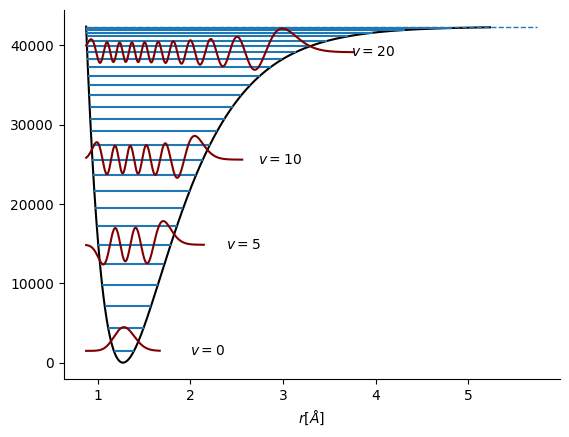
Anharmonic oscillator#
We can account for the deviation from the harmonic behavior by adding higher order polynomial terms \(\tilde{E}_v\). Addition of new terms allow for eventual dissociation to happen when molecule is excited to high vibrational energy states.
Unharmonic oscillator
\(\tilde{\nu}_e\) is the vibrational wavenumber
\(x_e\) and \(y_e\) are anharmonicity constants
\(v\) is the vibrational quantum number. Usually the third term is ignored and we can write the vibrational transition frequencies as (\(v\rightarrow v+1\)):
Overtone transitions#

Fig. 62 Illustration of overtone transitions#
The higher order terms are small but they give rise to overtone transitions with \(\Delta v = \pm 2, \pm 3, ...\) with rapidly decreasing intensities.
Example
Given \(\tilde{\nu}=536 cm^{-1}\) and \(x_e\tilde{\nu}=3.4 cm^{-1}\) for \(^{23}Na^{19}F\) molecule, calculate frequencies of first two overtones.
Solution
We make use of the equation \({\tilde{\nu}_{0\rightarrow v} = \tilde{\nu}_e \cdot v - 2\tilde{\nu}_ex_e v (v+1)}\) to compute transitions to levels 1 (fundamental), 2 (first overtone) and 3 (second overtone)
\(\tilde{\nu}_{0\rightarrow 1} = 1\tilde{\nu}_e - 2\tilde{\nu}_ex_e= 1\cdot536-2\cdot3.4=529 cm^{-1}\)
\({\tilde{\nu}_{0\rightarrow 2} = 2\tilde{\nu}_e - 6\tilde{\nu}_ex_e= 2\cdot536-6\cdot3.4}=1059 cm^{-1}\)
\({\tilde{\nu}_{0\rightarrow 3} = 3\tilde{\nu}_e - 12\tilde{\nu}_ex_e= 3\cdot536-12\cdot3.4}=1567 cm^{-1}\)
Population of vibrational states
Out of all possible vibrational states which states do molecules occupy at room temperature? For harmonic oscillator, the Boltzmann distribution gives the statistical weight for the \(v\) level:
Note that the degeneracy factor is identically one because there is no degeneracy in one dimensional harmonic oscillator. To proceed, we recall geometric series:
For example, for \(H^{35}Cl\) the thermal population of the first vibrational level \(v = 1\) is very small about \(9\times\) \(10^{-7}\).
This is why generally the excited vibrational levels do not contribute to the (IR) spectrum.
Vibrational modes of molecules#
A molecule has translational and rotational motion as a whole while each atom has it’s own motion. The vibrational modes can be IR or Raman active. For a mode to be observed in the IR spectrum, changes must occur in the permanent dipole (i.e. not diatomic molecules). Diatomic molecules are observed in the Raman spectra but not in the IR spectra. This is due to the fact that diatomic molecules have one band and no permanent dipole, and therefore one single vibration. An example of this would be \(O_2\) or \(N_2\).
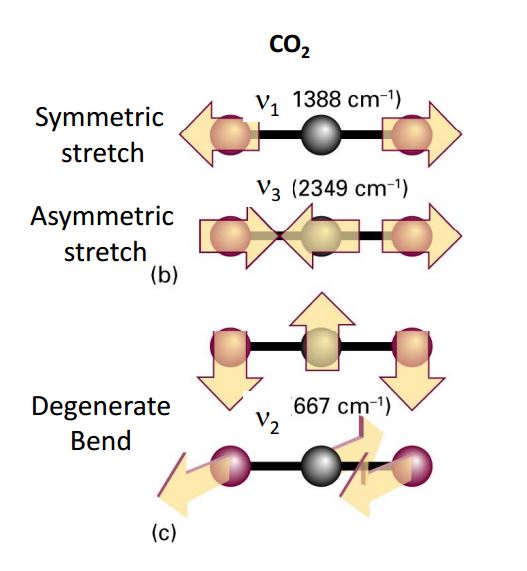
Fig. 63 Normal modes of \(CO_2\) with associated vibrational frequencies#
However, unsymmetric diatomic molecules (i.e. CN do absorb in the IR spectra. Polyatomic molecules undergo more complex vibrations that can be summed or resolved into normal modes of vibration. The normal modes of vibration are: asymmetric, symmetric, wagging, twisting, scissoring, and rocking for polyatomic molecules.
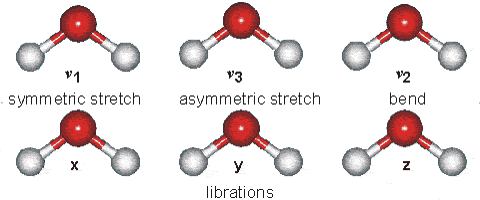
Fig. 64 Vibrational modes of water#
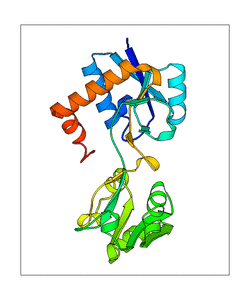
Fig. 65 Showing the slowest vibrational mode in protein which is linked with its catalytic function#
Vibrational degrees of freedom in molecules
Linear Molecules with N atoms:
Non-linear molecules with N atoms
Selection rules and Transition Dipole Moment#
Selection rules in spectroscopy are fundamental principles that dictate whether a transition is allowed or forbidden during the absorption or emission of electromagnetic radiation, such as infrared (IR) or Raman spectroscopy. The origins of these rules lie the fact that photon can induce coupling between the initial and final quantum states only under specific conditions.
In spectroscopy, allowed transitions are those with a non-zero transition dipole moment between the initial and final states.
Mathematically, the molecular dipole moment can be expanded around its equilibrium geometry \(R_e\). Here we will use dispacelent from equilibrum geometry \(x = R - R_e\) for convenience,
the transition dipole matrix element between vibrational states \(|v\rangle\) and \(|v'\rangle\) becomes:
Each term corresponds to an expectation value of powers of \(x\). We can interpret these terms as follows:
First term: \(\mu_e \langle v | v' \rangle = 0 \) for \(v \neq v'\) because the vibrational wavefunctions are orthogonal.
Second term: The term involving \(\langle v | x | v' \rangle\) can be nonzero only if the dipole moment changes with internuclear distance, i.e., \(\frac{\partial \mu}{\partial x} \neq 0\).
Higher-order terms: Usually small, but can contribute to overtones (\(\Delta v = 2, 3, \dots \)) when \(\mu(R)\) is strongly anharmonic.
Selection Rules for harmonic oscillator
A vibrational transition is allowed only if the molecular dipole moment changes with the bond length:
\(P_{v\rightarrow v'}\) probability of making transition from \(v\) to \(v'\) vibrational energy level
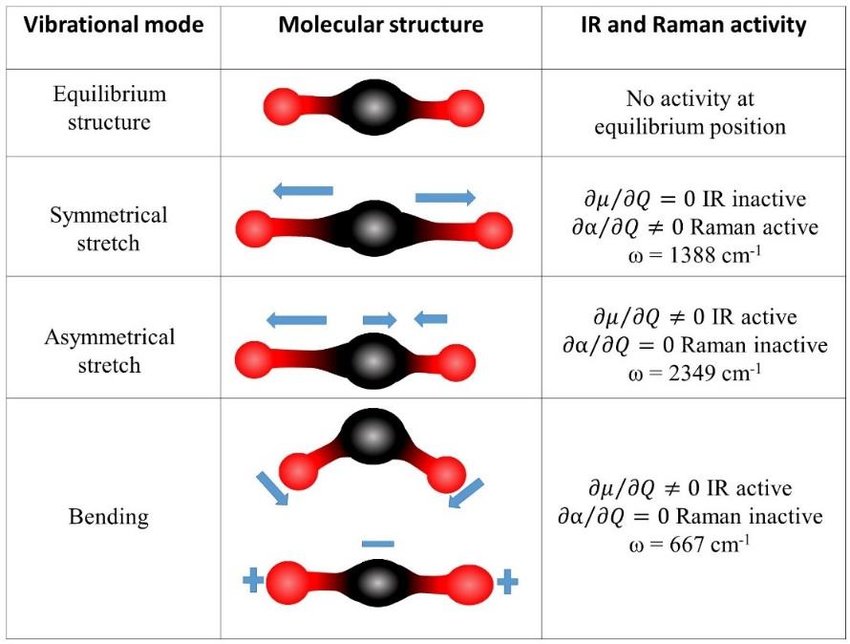
Fig. 66 Example of 2D IR spectorsocpy used to study protein by detecting amide group \(C=0\) vibrations in different parts of the molecules.#
All homonuclear diatomic molecules (e.g., \(H_2\), \(O_2\), etc.) have zero dipole moment, which cannot change as a function of \(R\). Hence these molecules do not show vibrational spectra.
In general, all molecules that have dipole moment have vibrational spectra as change in \(R\) also results in change of dipole moment. We still have the integral present in the second term.
For harmonic oscillator approximation, this integral is zero unless \(v'' = v'\pm 1\) . This provides an additional selection rule, which says that the vibrational quantum number may either decrease or increase by one.
IR spectra#

Fig. 67 IR spectral frequencies observed due to different vibrational frequencies of bonds in organic molecules.#
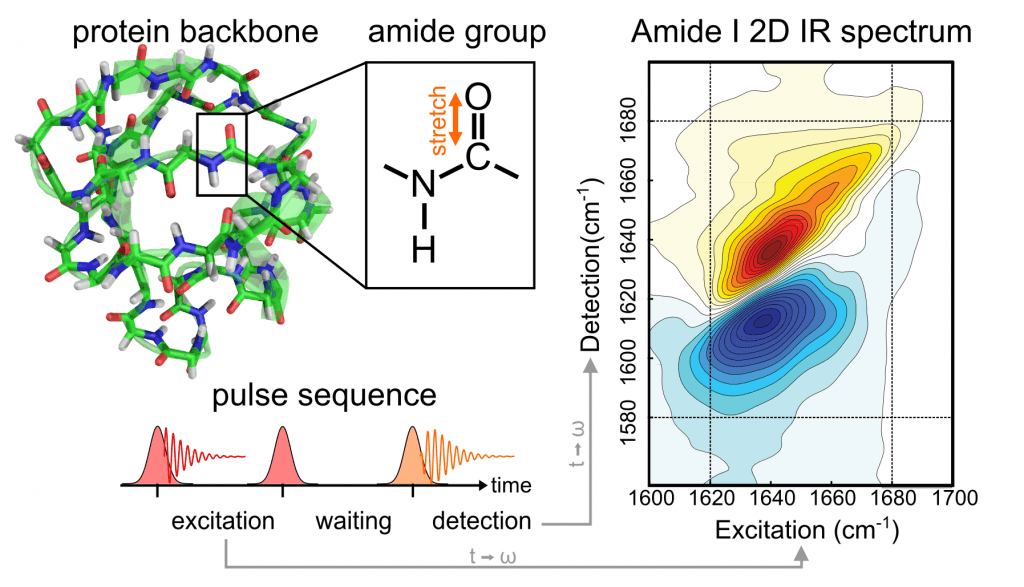
Fig. 68 Example of 2D IR spectorsocpy used to study protein by detecting amide group \(C=0\) vibrations in different parts of the molecules.#

